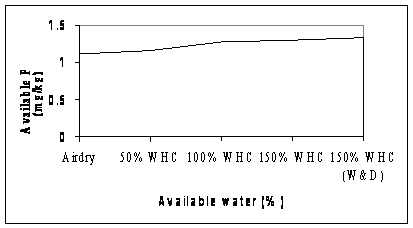
Friday, 14 July 2006
85-16
Photopedogenesis- New Chapter in Soil Science.
Light has been appreciated in soil science merely as a means of heat indicated by temperature change. However, presence of phototrophic bacteria including blue green algae, diurnal change in soil electrical conductivity, longer plant height at the centre of the densely seeded crop field, higher root proliferation during rainy season, vegetative cover change as affected by aspect (slope direction), more nitrogen efficiency in moist soils receiving intense light and possibly less infestation of insect, disease and weed during sunny period are some of exciting, but simple examples to recognize the direct role of light to the dynamics of soils in crop production. In a qualitative expression of the “Theory of Photopedology”, it was demonstrated that light can move to the soil layer in presence of moisture and may contribute to the ionization process of soil solution (1). In addition, low wavelength radiation like gamma and X-rays may increase the level of total and NH4-N and available phosphorus in soil at the cost of soil organic carbon content (Table 1). Forwarding a hypothesis, 12C6 and 16O8 already present in soil environment undergo nuclear transfer reaction (2) as induced by energy from X-rays and yield two atoms of 14N7 atom. In other experiment, increasing levels of water increased the soil available phosphorus significantly (Fig 1). Such radiation effects are related to the pedogenic state of soils and thus they are selective in nature.
Table 1. Effect of X-rays on some soil fertility parameters.
| Soil fertility parameter | Basalt derived soil | Limestone derived soil | ||||
| Untreated | X-ray treated | Gain (+) or loss (-) | Untreated | X-ray treated | Grain (+) or loss (-) | |
| Organic carbon, % | 1.82 | 1.69 | -0.13 | 4.12 | 3.97 | -0.15 |
| Total nitrogen, % | 0.106 | 0.134 | +0.028 | 0.322 | 0.340 | +0.018 |
| Available P, mg kg-1 | 21.69 | 23.19 | +1.500 | 14.38 | 16.81 | +2.43 |
| NH4-N, mg kg-1 | 3.81 | 6.72 | +2.910 | 6.49 | 6.72 | +0.23 |

Fig. 1. Available phosphorus of soil as affected by soil moisture levels
Conclusively, soil needs to be critically investigated in relation to photopedogenesis, wherein both short as well as long range of electromagetic radiations contribute significantly in relation to plant growth and development. Photopedogenesis thus seems to be the integral part of soil so long as soil is said to be a resource to plants as well as plant products. It is comparable in importance to photosynthesis for plant metabolism, but characteristic to soil alone in scientific merits.
References:
1. Mishra, B.B. 1096. Theory of Phtopedology. J. Indian Soc. Soil Sci. 44, 541-543.
2. Glasstone, S. 1967. Source Book on Atomic Energy, 3rd Ed. Dvan Nostrand Co. Ltd., Princeton, New Jersey, London.
Back to 1.3A New Frontiers in Soil Genesis - Theater
Back to WCSS
Back to The 18th World Congress of Soil Science (July 9-15, 2006)